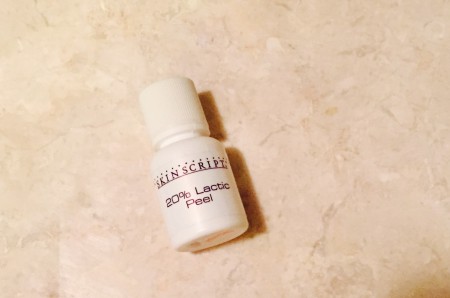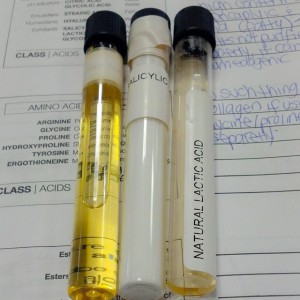Happy Tuesday readers! Hoping your weekend was great!
Awhile ago, I posted on alpha hydroxy acids, otherwise known as AHAs and why they are important in skincare. (In case you missed it or need a refresher, click here) Lactic acid was one of the AHAs mentioned and here’s why this ingredient is great.
Who: Lactic acid
What skin conditions can it help: Aging and hyperpigmentation
Where it comes from: Derived from milk/sugar
Why it’s important: Lactic acid functions as a humectant, which attracts water and hydrates the skin. It breaks down the bonds between cells that allow for easier exfoliation of the skin, reducing the appearance of wrinkles. It also reduces hyperpigmentation due to its ability to suppress the formation of tyrosinase ( the enzyme involved in melanin production). Because its molecular structure is bigger than glycolic acid, it’s an ideal ingredient to use for those who have sensitive skin because it permeates into the skin slowly, reducing the chances of irritation and inflammation.
How it’s used: Lactic acid can be found in skincare products (i.e. cleansers, toners, moisturizers, serums) and also in professional treatments like chemical peels. *Like any other exfoliating agent, limit use to a few times per week, wear sunscreen and use caution when using ingredients containing retinol as this can irritate skin.
If you follow my Instagram, you’ll recognize the picture below when I took the Cosmetic Chemistry course at UCLA. The vial on the right-hand side is what natural lactic acid looks like.
I recently joined Twitter (@stephieestie) so feel free to follow me on there too! I’m still learning how to use it, FYI, but I’m sure I’ll get it in no time. 🙂
Thanks for reading,
Stephanie


Awesome post. Love my acids,although I tend to go a bit crazy sometimes n my skin goes mental producing extra oil to condensate for the loss 🙈
Thanks! I know what you mean. I know better but sometimes I get super excited and then have to deal with the consequences, lol.
Happy Tuesday! Thanks for the awesome info!!! 🙂 Everything in moderation is key, huh?
You’re welcome and yes, moderation is key. 🙂 We had this discussion in class last month on ‘toxic’ ingredients and even water is toxic at high levels yet is natural. I’m telling you, sometimes I get an information overload that leaves me spinning but I try to break it down and simplify it. 🙂
Pingback: Why AHAs Are Important in Anti-Aging Skincare! | Stephie Estie
Great post!! Happy Tuesday Stephanie! Even though it’s almost over with lol. I love these posts and always am learning something new! 🙂 xo
Thanks Katie! I’m so glad you enjoy them. 🙂
You’re welcome Stephanie 🙂
another great post lovely! the most amazing thing about this acid is that it can be used on sensitives skins as well… with certain limitations and mandatory steps ( like the use of SPF daily, which we should anyway! etc… ) to follow!
lots of xx, Annie | Annie’s Beauty
Thanks Annie! Yes, it is a better choice than say glycolic for sensitive skin and also great to use for darker skin types (higher Fitzpatrick). You know how I feel about sunscreen-a must everyday but especially when ingredients like these are used. Thanks for stopping by! 🙂
Cool! Thanks for profiling.
Thanks!
Very educational post 🙂 Exfoliation is not really common in my country so I still need to learn about this type of ingredients. Thanks for sharing, Stephanie! ❤
Thanks Maiko! You’re welcome. 🙂
I nominated you for the Blog Tour Award! You can check it out here! https://thebeautifiedblogger.wordpress.com/2015/05/20/blog-tour-award/
🙂
Great post! Such useful information.xo
Thank you! 🙂
I love lactic acid! I have a peel also from makeupartistschoice and it really helped clear up my complexion.
I’ve never heard of that brand. Will have to research. Thanks for stopping by. 🙂
What a great post! Super informative 🙂 thank you for sharing
Thank you and you’re welcome! 🙂
I value you sharing this information with us!! I always look forward to your posts :0)
Thank you Jacqueline! Sometimes I get worried because it’s more scientific but when I get positive feedback, it encourages me to keep going. 🙂
Yes! Please keep going. I wonder all the time what these “beneficial” ingredients are, but don’t have the time to do the research that I’d like to do. So, thank you!!
Thank you! I have a few more AHAs to go through so be on the lookout for those. Thanks so much for the support and encouragement-means a lot! xo
Thanks for the excellent explanation. Love hearing the science behind lactic acid 😁
You’re very welcome and thanks for reading. xo 🙂
Pingback: The Acid Chronicles: Glycolic Acid! | Stephie Estie